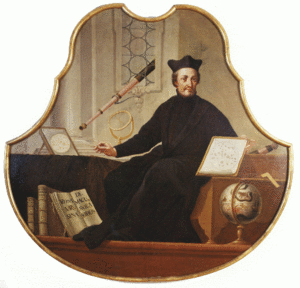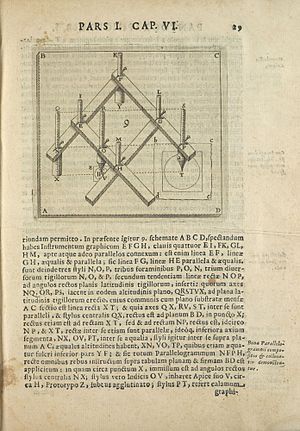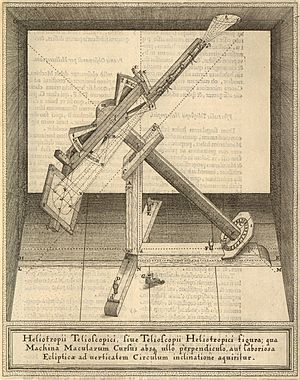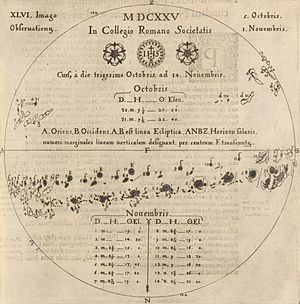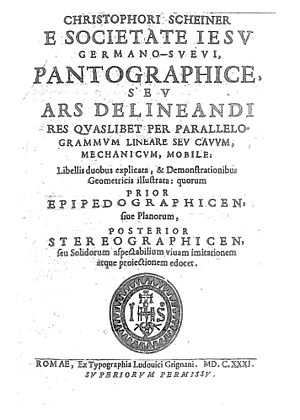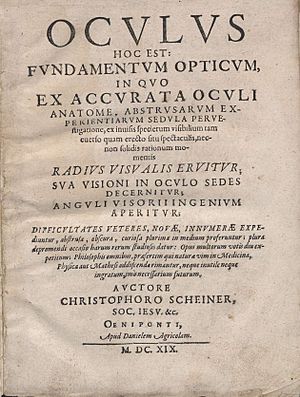Christoph Scheiner facts for kids
Christoph Scheiner (born July 25, 1573 or 1575 – died June 18, 1650) was a Jesuit priest, physicist, and astronomer. He lived in Ingolstadt, a city in Germany. Scheiner was known for his important discoveries and inventions, especially in the fields of optics and astronomy.
Contents
Life and Discoveries
Early Life and Education: 1591–1605
Christoph Scheiner was born in Markt Wald, a small town in Germany. He went to a Jesuit school in Augsburg from 1591 to 1595. After finishing school, he joined the Jesuit Order in 1595. The Jesuits are a religious group known for their focus on education and science.
From 1598 to 1601, Scheiner studied philosophy and mathematics in Ingolstadt. In 1603, he invented a cool tool called the pantograph. This device could copy drawings and plans, making them bigger or smaller. It was a very useful invention for artists and engineers of his time.
Teaching and Sunspots: 1605–1617
Scheiner continued his studies in Ingolstadt, focusing on theology. Because of his pantograph invention, he was already quite famous. Even Duke William V of Bavaria invited him to show off his invention.
In 1609, he became a priest. From 1610 to 1617, Scheiner taught mathematics, physics, and astronomy in Ingolstadt. He gave lectures on many topics, including sun dials, geometry, and how telescopes work.
In 1611, Scheiner made an important observation: he saw sunspots on the Sun! He published his findings in letters called the "Apelles letters" in 1612. This led to a big disagreement with another famous scientist, Galileo Galilei. Both Scheiner and Galileo observed sunspots around the same time. This caused a debate about who saw them first and how to explain them.
New Inventions and the Eye: 1617–1624
After 1617, Scheiner moved to Innsbruck, Austria. There, he helped Archduke Maximilian III with his telescope. Maximilian had a telescope that showed things upside down. Scheiner added a third lens to it, creating a terrestrial telescope. This made objects appear upright, which was great for looking at landscapes.
Scheiner also developed a portable camera obscura in Innsbruck. This was a dark box with a small hole that projected an image onto a screen. He even built a large, walk-in camera obscura!
In 1619, Scheiner published a book called "Oculus," which means "Eye." This book had many new ideas about how the human eye works. He explained the anatomy of the eye, how light bends inside it, and how the retina (the back of the eye) receives images. Like Johannes Kepler before him, Scheiner realized that the retina is where vision happens. He also understood that the optic nerve sends these images to the brain.
Studying the Sun in Rome: 1624–1633
In 1624, Scheiner traveled to Rome. His friends encouraged him to write more about his observations of the Sun. He spent time studying other scientific books, including Galileo's work on sunspots. Both scientists had similar findings, which unfortunately led to accusations of copying each other's work and a strong rivalry.
Between 1626 and 1630, Scheiner wrote his most famous book, Rosa Ursina sive Sol (meaning "The Ursine Rose, or the Sun"). This book became a very important guide for studying sunspots for many years.
In this book, Scheiner described telescopes and different ways to project images of the Sun. He also compared how telescopes work to how our eyes see. Most importantly, he shared a huge collection of data from his sunspot observations. He also discussed how the Sun rotates every 27 days and how its axis is tilted.
Scheiner also published Pantographice in Rome, which was all about his pantograph invention. His last work, Prodromus, was published after he died. It argued against the idea that the Earth moves around the Sun (the heliocentric theory).
Later Years: 1633–1650
After his time in Rome, Scheiner moved to Vienna and then to Neisse (now in Poland). In Neisse, he continued to serve the Jesuit college as an advisor and mentor. He died there on June 18, 1650. His obituary mentioned that he was a modest and hardworking person who loved to read, write, and even tend his garden.
Important Books
Here are some of Christoph Scheiner's key works:
- Tres epistolae de maculis solaribus (Three Letters on Sunspots) (Augsburg, 1612)
- De Maculis solaribus et stellis circa Iovis errantibus accuratior Disquisitio (A More Accurate Discussion of Sunspots and Stars Wandering Around Jupiter) (Augsburg, 1612)
- Disquisitiones mathematicae (Mathematical Discussions) (Ingolstadt, 1614)
- Sol ellipticus (The Elliptical Sun) (Augsburg, 1615)
- Refractiones coelestes sive solis elliptici phaenomenon illustratum (Celestial Refractions or the Phenomenon of the Elliptical Sun Explained) (Ingolstadt, 1617)
- Oculus, hoc est: Fundamentum opticum (The Eye, that is: The Foundation of Optics) (Innsbruck, 1620)
- Rosa Ursina sive Sol (The Ursine Rose, or the Sun) (Bracciano, 1626–30)
- Pantographice seu ars delineandi (Pantography or the Art of Drawing) (Rome, 1631)
- Prodromus pro sole mobili et terra stabili contra ... Galilaeum a Galileis (Introduction for the Moving Sun and Stable Earth against ... Galileo Galilei) (Prague, 1651, published after his death)
Legacy
Christoph Scheiner's work is still remembered today.
- A primary school in his hometown of Markt Wald is named after him.
- In Ingolstadt, there is a high school called Christoph-Scheiner-Gymnasium.
- A street near the university observatory in Munich and a road in Berlin are named in his honor.
- In 1999, a special coin with his face on it was made in Ingolstadt.
- A lunar crater on the Moon is named "Scheiner" after him.
- Austria issued a postage stamp in his honor in 2005.
See also
 In Spanish: Christoph Scheiner para niños
In Spanish: Christoph Scheiner para niños
- List of Jesuit scientists
- List of Roman Catholic scientist-clerics


